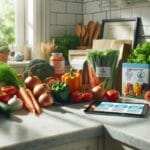How To Scan Food Labels For Gluten: A Parent’s Guide & App Solution
Confession time: I never thought a simple plate of pasta could send my son to the ER. But there we were, panic rising as his face broke out in hives after one innocent-looking dinner. That night, I realized how complicated—and critical—reading food labels for gluten truly is. If you’re a parent or anyone with gluten sensitivity, you know the anxiety of standing in a grocery aisle, squinting at tiny ingredient lists, wondering, “Is this safe?” Let’s talk about how to scan food labels for gluten, the science behind labeling, and the tech that can make life easier.
Why Scanning Food Labels for Gluten Matters
Gluten is a protein found in wheat, barley, rye, and their derivatives. For people with celiac disease, wheat allergy, or non-celiac gluten sensitivity, even trace amounts can trigger severe reactions [PubMed]. According to the FDA, about 1% of the U.S. population has celiac disease, but millions more avoid gluten for health reasons.
- Celiac disease: An autoimmune disorder causing intestinal damage.
- Wheat allergy: Immune response to wheat proteins, including gluten.
- Gluten sensitivity: Symptoms without autoimmune markers.
Identifying gluten is not always straightforward. Ingredients like “malt extract,” “modified food starch,” or “hydrolyzed vegetable protein” may hide gluten [EFSA]. That’s why learning how to scan food labels for gluten is a must-have skill for anyone managing a gluten-free diet.
Understanding Food Labeling Laws: US vs EU
| Region | Allergen Disclosure | Gluten-Free Definition | Authority |
|---|---|---|---|
| United States | Mandatory for top 8 allergens, including wheat | <20 ppm gluten | FDA |
| European Union | Mandatory for 14 allergens, including gluten-containing cereals | <20 ppm gluten | EFSA |
Both the FDA and EFSA require gluten to be declared, but the list of mandatory allergens differs. In the U.S., “wheat” must be listed, but barley and rye are not always explicitly named. In the EU, “gluten-containing cereals” (wheat, rye, barley, oats, spelt, kamut) must be highlighted in the ingredients. This means a product labeled “gluten-free” in one country may not be in another [NY Times].
How to Scan Food Labels for Gluten: Step-by-Step
-
Look for “Gluten-Free” Certification:
- Products labeled “gluten-free” in the U.S. must contain less than 20 parts per million (ppm) of gluten [FDA].
- In the EU, the same threshold applies, but labeling may also specify “very low gluten” (<100 ppm).
-
Check the Allergen Statement:
- Look for “Contains wheat,” “Contains gluten,” or similar phrases.
- In the EU, allergens are often bolded or underlined in the ingredient list.
-
Scrutinize the Ingredient List:
- Watch for wheat, barley, rye, malt, brewer’s yeast, and oats (unless certified gluten-free).
- Be wary of ambiguous terms like “starch,” “flour,” or “hydrolyzed protein.”
-
Look for Cross-Contamination Warnings:
- Statements like “may contain traces of wheat” signal potential risk.
-
When in Doubt, Use a Food Scanner App:
- Apps like Food Scan Genius can instantly analyze barcodes and ingredient lists for gluten and other allergens.
Even seasoned label-readers can get tripped up by unfamiliar ingredients or regional differences. That’s where technology comes in.
How Food Scan Genius Makes Gluten Scanning Easy
Food Scan Genius is a mobile app designed for people with food sensitivities, allergies, or dietary preferences. Here’s how it helps you scan food labels for gluten:
- Barcode Scanning: Instantly checks products for gluten and other allergens by scanning the barcode.
- Ingredient Analysis: AI-powered recognition identifies hidden sources of gluten, even in complex ingredient lists.
- Personalized Profiles: Set your dietary preferences (e.g., gluten-free, dairy-free, vegan) for tailored results.
- Global Database: Covers products from the US, EU, and beyond, with region-specific labeling rules.
- Real-Time Updates: Access the latest labeling laws, recalls, and scientific findings.
“As a mom of two with celiac, Food Scan Genius is a lifesaver. I just scan the barcode, and it tells me instantly if a product is safe—even when we’re traveling in Europe. I recommend it to every parent I know!” – Jessica R., Boston, MA
Ready to make shopping stress-free? Download Food Scan Genius now and never second-guess a label again.
Common Hidden Sources of Gluten
Some ingredients may contain gluten even if “wheat” or “barley” isn’t obvious. Here’s a quick reference table:
| Ingredient | Gluten Risk? | Notes |
|---|---|---|
| Malt extract | Yes | Usually from barley |
| Modified food starch | Sometimes | If from wheat, must be declared in US/EU |
| Hydrolyzed vegetable protein | Sometimes | Check source (wheat, soy, corn) |
| Oats | Sometimes | Risk of cross-contamination unless certified gluten-free |
| Brewer’s yeast | Yes | Often a byproduct of beer (barley) |
For a full list, see the Celiac Disease Foundation.
Q&A: How to Scan Food Labels for Gluten
Q: What’s the fastest way to know if a product is gluten-free?
A: Look for a “gluten-free” label or certification. If in doubt, scan the barcode using Food Scan Genius for instant results.
Q: Are US and EU gluten-free labels the same?
A: Both require less than 20 ppm gluten, but the list of allergens that must be disclosed differs. Always double-check when traveling.
Q: Can I trust “may contain traces of wheat” labels?
A: These labels indicate possible cross-contamination. If you have celiac disease or severe sensitivity, avoid these products.
Q: What if the ingredient list is unclear?
A: Use a scanner app like Food Scan Genius, or contact the manufacturer for clarification.
Latest Research and News on Gluten Labeling
- NY Times: “Are Gluten-Free Labels Always Accurate?”
- FoodNavigator: “EU Reviews Gluten Labelling Rules”
- ScienceDirect: “Hidden Gluten in Processed Foods”
Ongoing research shows that mislabeling and cross-contamination remain challenges. Apps like Food Scan Genius help bridge the gap between regulation and real-world safety.
Tips for Safe Gluten-Free Shopping
- Stay updated: Labeling laws change. Follow FDA and EFSA updates.
- Double-check international products: Allergen rules differ by country.
- Use technology: Food Scan Genius can save time and prevent mistakes.
- Join support groups: Online communities often share product alerts and safe brands.
Conclusion: From Confusion to Confidence
That night in the ER changed the way I shop forever. Today, I don’t just read labels—I scan them, analyze them, and double-check them with Food Scan Genius. Understanding how to scan food labels for gluten isn’t just about avoiding hives or stomachaches; it’s about peace of mind. Whether you’re managing celiac disease, a wheat allergy, or just want to eat cleaner, the right tools and knowledge make all the difference.
Don’t let confusing labels or outdated laws put your family at risk. Download Food Scan Genius today, and shop with confidence—wherever you are in the world.
FAQ: How to Scan Food Labels for Gluten
- Is gluten always listed on food labels?
- No. In the US, only wheat is a mandatory allergen. In the EU, gluten-containing cereals must be highlighted. Always check ingredient lists and use a scanner app for hidden sources.
- What does “gluten-free” mean legally?
- In both the US and EU, “gluten-free” means less than 20 ppm gluten, per FDA and EFSA regulations.
- Can I use Food Scan Genius outside the US?
- Yes. Food Scan Genius covers products from the US, EU, and other regions, adapting to local labeling laws.
- How accurate are scanner apps?
- Accuracy depends on the database and AI. Food Scan Genius uses a global, regularly updated database and advanced ingredient analysis for best results.





